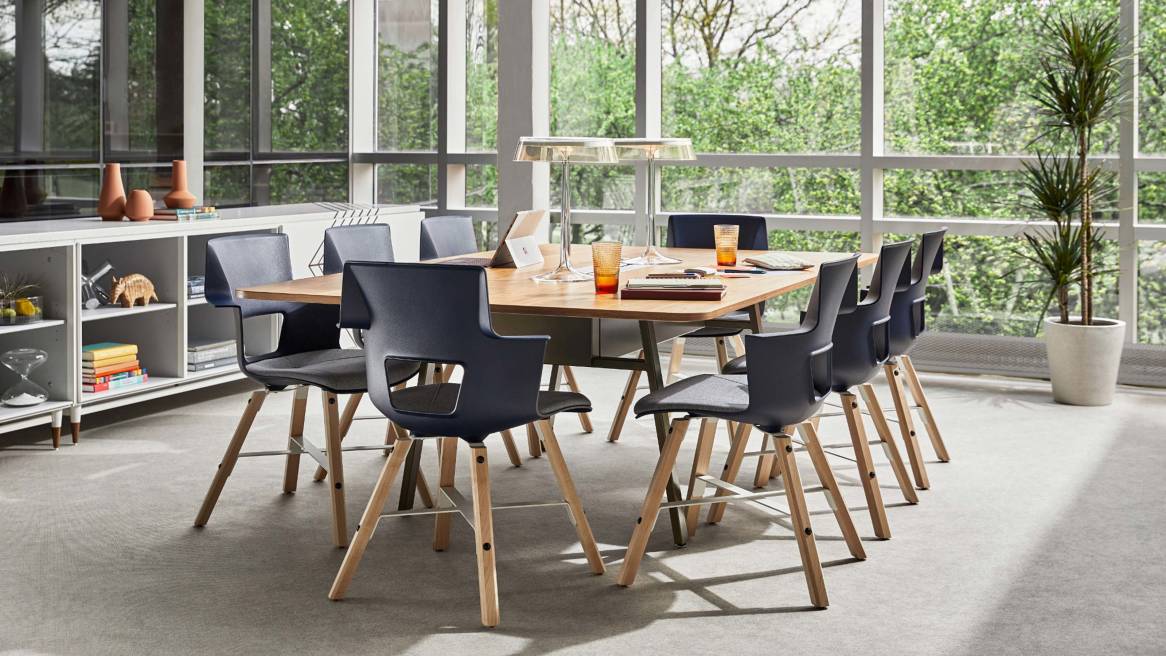Shared experiences help create the sense of belonging we need whether we’re at home or at work.
By Dr. Tracy Brower, PhD., MM, MCR.
Thanks to technology and mobility, our work has come home with us.
So it’s only fair that home should come to work, right?
It would seem logical that if people sit in front of a TV on the sofa at home while they work remotely, employees would be thrilled to have a similar set up within their office. However, in the workplaces where we’ve seen companies install couches and big screen TVs, those work spaces are almost never used by employees. Those companies missed the bigger picture. Home is as much an emotional experience as a physical one. It’s more than just about comfy seating or watching the game.
Work isn’t where you go; it’s what you do. Home is similar. Yes, it is a place you go, but more than that, it’s an experience you have. Similarly, the best workplaces create memories, capture events and tell stories. In the classic Management by Storying Around, David Armstrong advocates for more storytelling by leaders who want to cement experiences, communicate values, and reinforce membership in the organisation. Shared experiences help create the sense of belonging we need whether we’re at home, or yes, at work.
Family sociologists like to invoke the Anna Karenina rule, named for the opening line in the Leo Tolstoy book: ‘Happy families are all alike; every unhappy family is unhappy in its own way.’ Not all home life is happy, but there are some shared principles that work really well when we take them to work. Belonging, trust, and safety make the list, but there are more to these.

Clearing the table.
At home, we have a role to play. The best home experiences aren’t where we get to do whatever we want, but where we’re counted on for specific tasks and contributions. In our home, for example, our son and daughter alternated clearing and wiping the table after dinner each night. While they detested the chore and would argue about whose turn it was (and still do), deep down they knew they were important to the household and had a contribution to make. Work is like this too. In an effective workplace, we each have a role to play and having meaningful work gives us purpose. When we’re valued for what we do, recognised for it and held accountable, we see how our contribution matters to the business.
No dirty socks.
I’ve always thought if we’re not driving our kids a bit crazy, we’re probably not doing our jobs as parents. We ensure they rinse their cereal bowl before putting it in the dishwasher and don’t allow them to leave their dirty socks laying around. The best home life allows us to truly relax and just be ourselves, but it also holds us accountable. Work should be like this too. A culture is defined by the worst behaviour it is willing to tolerate, and a workplace where we’re held accountable for what we do and how we do it is one where performance and people get the payoff.
We once worked with a client who believed there were brilliant ‘people-people’ – those good at building trust and teams, and there were brilliant technicians with pedigree and stellar resumes — who also happened to be jerks. The brilliant technicians weren’t held accountable for how they approached other people. The environment quickly turned toxic. As they built their way to a more constructive culture, it was important that all employees were held accountable for how they treated others and how they achieved results. No one was allowed to leave their dirty socks around for others to pick up.
Teenagers and toddlers.
They say the times when home happiness declines are during the toddler and teenage years. That’s because these are the years children test limits and push boundaries most significantly. While challenging, these are also the times when humans are growing most into themselves, finding their voices, and exercising autonomy. These are the things that make for healthy adults – and as it turns out, healthy workplaces.

Being appreciated in spite of it all.
Perhaps most of all, at home we’re able to just be ourselves. It’s a place where people know us well, and beyond liking us because they know us, they like us in spite of what they know about us – warts and all. The best workplaces are like this too. Employees at one company we worked with said they felt like they had to ‘put on their armour’ when they walked in the door. This is antithetical to a great experience. Creating the emotional experience of home at work means people feel safe to truly be themselves and they can trust others to hold them in positive regard.
Our daughter’s university rowing coach likes to say to her perfectionist crew, ‘You will never be perfect, you will have to settle for being excellent.’ This is the idea. Work doesn’t allow us to be complacent. It spurs us to be better and to stretch and develop. When we bring home to work, we are able to bring our best selves and our fullest selves to work. In turn, the workplace brings out our best and pushes us to be better.
At the end of the day, home is a place where we have an attachment. It’s our territory and our cocoon. It’s a place where we care about the people and the circumstances. This is the best of the work experience, too. Just like the Anna Karenina rule, great workplaces have similar characteristics. At its best, the workplace engages us, pulls us in, and requires our passion. Slacking isn’t fulfilling, but being challenged to exercise our skills and talents is. This is the best of bringing home to work: a workplace that creates the conditions for us to be our best, alongside colleagues whom we value and who value us.
Dr. Tracy Brower is a sociologist focused on work, workers, and workplace. She is a Principal with the Applied Research + Consulting group at Steelcase and the author of Bring Work to Life by Bringing Life to Work: A Guide for Leaders and Organizations (2014). Tracy contributes as a board member with the IFMA Research & Benchmarking Institute as well as an executive advisor for Coda Societies and for Michigan State University’s Graduate Mathematics Program.






.png)



